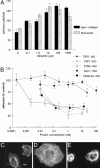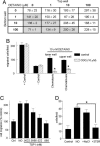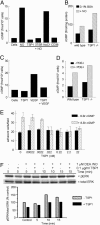Thrombospondin-1 inhibits endothelial cell responses to nitric oxide in a cGMP-dependent manner
- PMID: 16150726
- PMCID: PMC1201579
- DOI: 10.1073/pnas.0502977102
Thrombospondin-1 inhibits endothelial cell responses to nitric oxide in a cGMP-dependent manner
Abstract
Redox signaling plays an important role in the positive regulation of angiogenesis by vascular endothelial growth factor, but its role in signal transduction by angiogenesis inhibitors is less clear. Using muscle explants in 3D culture, we found that explants from mice lacking the angiogenesis inhibitor thrombospondin-1 (TSP1) exhibit exaggerated angiogenic responses to an exogenous NO donor, which could be reversed by providing exogenous TSP1. To define the basis for inhibition by TSP1, we examined the effects of TSP1 on several proangiogenic responses of endothelial cells to NO. NO has a biphasic effect on endothelial cell proliferation. The positive effect at low doses of NO is sensitive to inhibition of cGMP signaling and picomolar concentrations of TSP1. NO stimulates both directed (chemotactic) and random (chemokinetic) motility of endothelial cells in a cGMP-dependent manner. TSP1 potently inhibits chemotaxis stimulated by NO. Low doses of NO also stimulate adhesion of endothelial cells on type I collagen in a cGMP-dependent manner. TSP1 potently inhibits this response both upstream and downstream of cGMP. NO-stimulated endothelial cell responses are inhibited by recombinant type 1 repeats of TSP1 and a CD36 agonist antibody but not by the N-terminal portion of TSP1, suggesting that CD36 or a related receptor mediates these effects. These results demonstrate a potent antagonism between TSP1 and proangiogenic signaling downstream of NO. Further elucidation of this inhibitory signaling pathway may identify new molecular targets to regulate pathological angiogenesis.
Figures





References
-
- Maulik, N. (2002) Antioxid. Redox Signal. 4, 783–784. - PubMed
-
- Morbidelli, L., Donnini, S., Chillemi, F., Giachetti, A. & Ziche, M. (2003) Clin. Cancer Res. 9, 5358–5369. - PubMed
-
- Zaragoza, C., Soria, E., Lopez, E., Browning, D., Balbin, M., Lopez-Otin, C. & Lamas, S. (2002) Mol. Pharmacol. 62, 927–935. - PubMed
-
- Raj, U. & Shimoda, L. (2002) Am. J. Physiol. 283, L671–L677. - PubMed
-
- Oliveira, C. J., Schindler, F., Ventura, A. M., Morais, M. S., Arai, R. J., Debbas, V., Stern, A. & Monteiro, H. P. (2003) Free Radical Biol. Med. 35, 381–396. - PubMed
Publication types
MeSH terms
Substances
LinkOut - more resources
Full Text Sources
Other Literature Sources
Molecular Biology Databases
Miscellaneous

